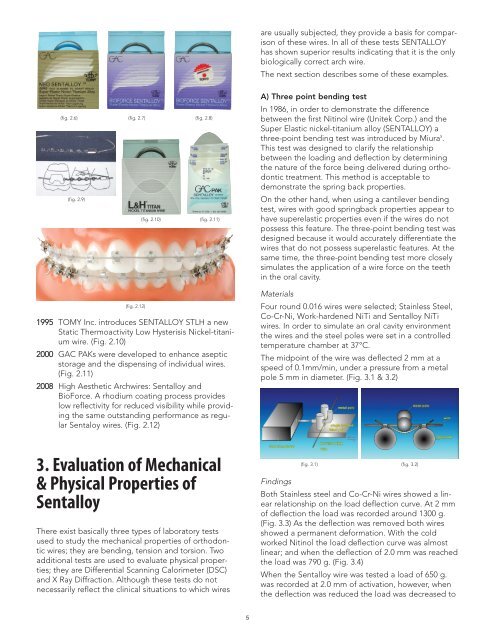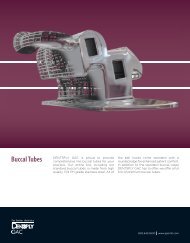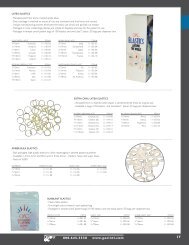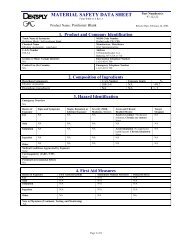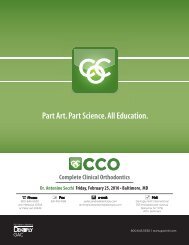SENTALLOY® - GAC International
SENTALLOY® - GAC International
SENTALLOY® - GAC International
You also want an ePaper? Increase the reach of your titles
YUMPU automatically turns print PDFs into web optimized ePapers that Google loves.
(fig. 2.6) (fig. 2.7) (fig. 2.8)<br />
(fig. 2.9)<br />
(fig. 2.12)<br />
(fig. 2.10) (fig. 2.11)<br />
1995 TOMY Inc. introduces SENTALLOY STLH a new<br />
Static Thermoactivity Low Hysterisis Nickel-titanium<br />
wire. (Fig. 2.10)<br />
2000 <strong>GAC</strong> PAKs were developed to enhance aseptic<br />
storage and the dispensing of individual wires.<br />
(Fig. 2.11)<br />
2008 High Aesthetic Archwires: Sentalloy and<br />
BioForce. A rhodium coating process provides<br />
low reflectivity for reduced visibility while providing<br />
the same outstanding performance as regular<br />
Sentaloy wires. (Fig. 2.12)<br />
3. Evaluation of Mechanical<br />
& Physical Properties of<br />
Sentalloy<br />
There exist basically three types of laboratory tests<br />
used to study the mechanical properties of orthodontic<br />
wires; they are bending, tension and torsion. Two<br />
additional tests are used to evaluate physical properties;<br />
they are Differential Scanning Calorimeter (DSC)<br />
and X Ray Diffraction. Although these tests do not<br />
necessarily reflect the clinical situations to which wires<br />
5<br />
are usually subjected, they provide a basis for comparison<br />
of these wires. In all of these tests SENTALLOY<br />
has shown superior results indicating that it is the only<br />
biologically correct arch wire.<br />
The next section describes some of these examples.<br />
A) Three point bending test<br />
In 1986, in order to demonstrate the difference<br />
between the first Nitinol wire (Unitek Corp.) and the<br />
Super Elastic nickel-titanium alloy (SENTALLOY) a<br />
three-point bending test was introduced by Miura5 .<br />
This test was designed to clarify the relationship<br />
between the loading and deflection by determining<br />
the nature of the force being delivered during orthodontic<br />
treatment. This method is acceptable to<br />
demonstrate the spring back properties.<br />
On the other hand, when using a cantilever bending<br />
test, wires with good springback properties appear to<br />
have superelastic properties even if the wires do not<br />
possess this feature. The three-point bending test was<br />
designed because it would accurately differentiate the<br />
wires that do not possess superelastic features. At the<br />
same time, the three-point bending test more closely<br />
simulates the application of a wire force on the teeth<br />
in the oral cavity.<br />
Materials<br />
Four round 0.016 wires were selected; Stainless Steel,<br />
Co-Cr-Ni, Work-hardened NiTi and Sentalloy NiTi<br />
wires. In order to simulate an oral cavity environment<br />
the wires and the steel poles were set in a controlled<br />
temperature chamber at 37°C.<br />
The midpoint of the wire was deflected 2 mm at a<br />
speed of 0.1mm/min, under a pressure from a metal<br />
pole 5 mm in diameter. (Fig. 3.1 & 3.2)<br />
(fig. 3.1) (fig. 3.2)<br />
Findings<br />
Both Stainless steel and Co-Cr-Ni wires showed a linear<br />
relationship on the load deflection curve. At 2 mm<br />
of deflection the load was recorded around 1300 g.<br />
(Fig. 3.3) As the deflection was removed both wires<br />
showed a permanent deformation. With the cold<br />
worked Nitinol the load deflection curve was almost<br />
linear; and when the deflection of 2.0 mm was reached<br />
the load was 790 g. (Fig. 3.4)<br />
When the Sentalloy wire was tested a load of 650 g.<br />
was recorded at 2.0 mm of activation, however, when<br />
the deflection was reduced the load was decreased to


